Like the ancient hanging gardens of Babylon, your bathroom can become a verdant sanctuary with the right selection of plants. You’ll discover how strategic placement of greenery can transform your daily routine into a spa-like experience, while naturally purifying the air you breathe. From low-light warriors like snake plants that thrive in shadowy corners to humidity-loving orchids that flourish in shower steam, these nine plant suggestions will help you create your own botanical oasis.
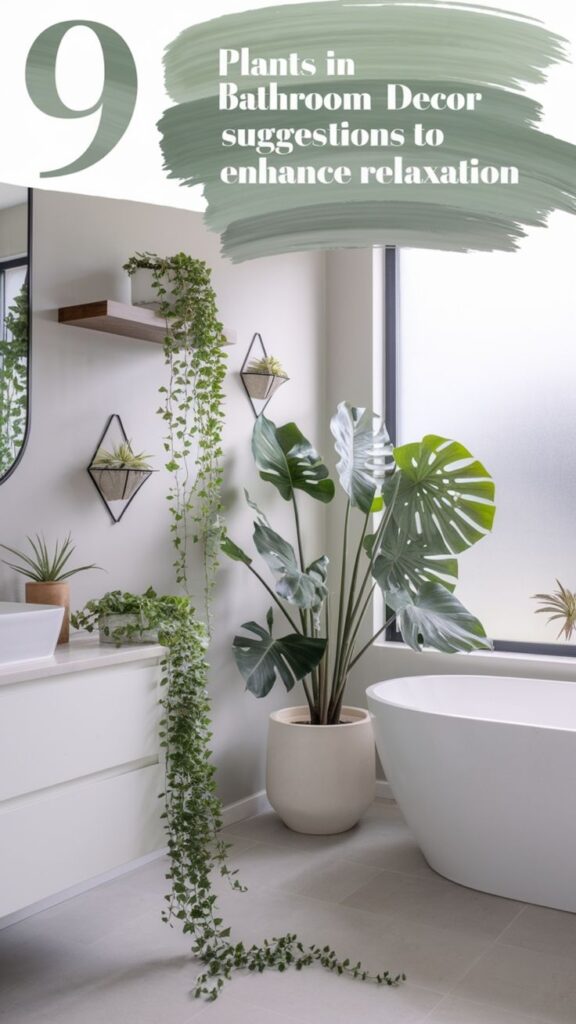
Contents
- 1 Best Low-Light Plants for Windowless Bathrooms
- 2 Humidity-Loving Plants That Thrive in Shower Steam
- 3 Space-Saving Hanging Plants for Small Bathrooms
- 4 Air-Purifying Plants to Combat Bathroom Odors
- 5 Water-Resistant Plants for Wet Environments
- 6 Bathroom Plants That Require Minimal Maintenance
- 7 Colorful Plants to Brighten Your Bathroom Space
- 8 Pet-Safe Plants for Family Bathrooms
- 9 Decorative Placement Ideas for Bathroom Plants
Best Low-Light Plants for Windowless Bathrooms
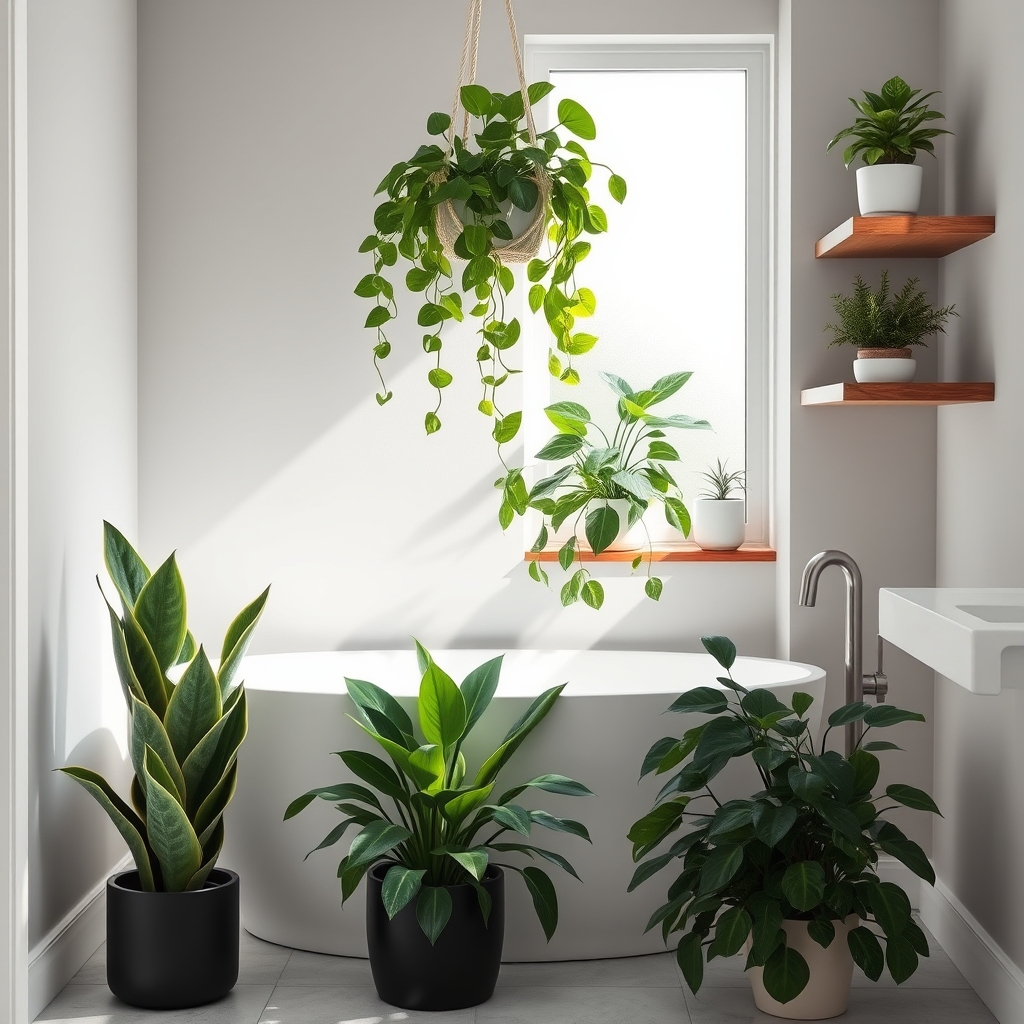
Several plants thrive in the low-light conditions of windowless bathrooms while adding natural beauty to the space.
Snake plants (Sansevieria) feature tall, rigid leaves with striking patterns and can survive in near-darkness. ZZ plants (Zamioculcas zamiifolia) display glossy, dark green leaves and are virtually indestructible in low-light environments.
Chinese evergreens (Aglaonema) offer variegated foliage patterns and excellent humidity tolerance. Pothos plants trail elegantly from shelves or hanging baskets, with heart-shaped leaves in various shades of green.
Cast iron plants (Aspidistra elatior) maintain their sturdy, dark green leaves even in minimal light conditions.
These plants not only survive but can thrive in bathroom environments due to their ability to tolerate high humidity and limited natural light.
Most require minimal maintenance and help purify the air while adding a spa-like atmosphere to windowless bathrooms.
Humidity-Loving Plants That Thrive in Shower Steam
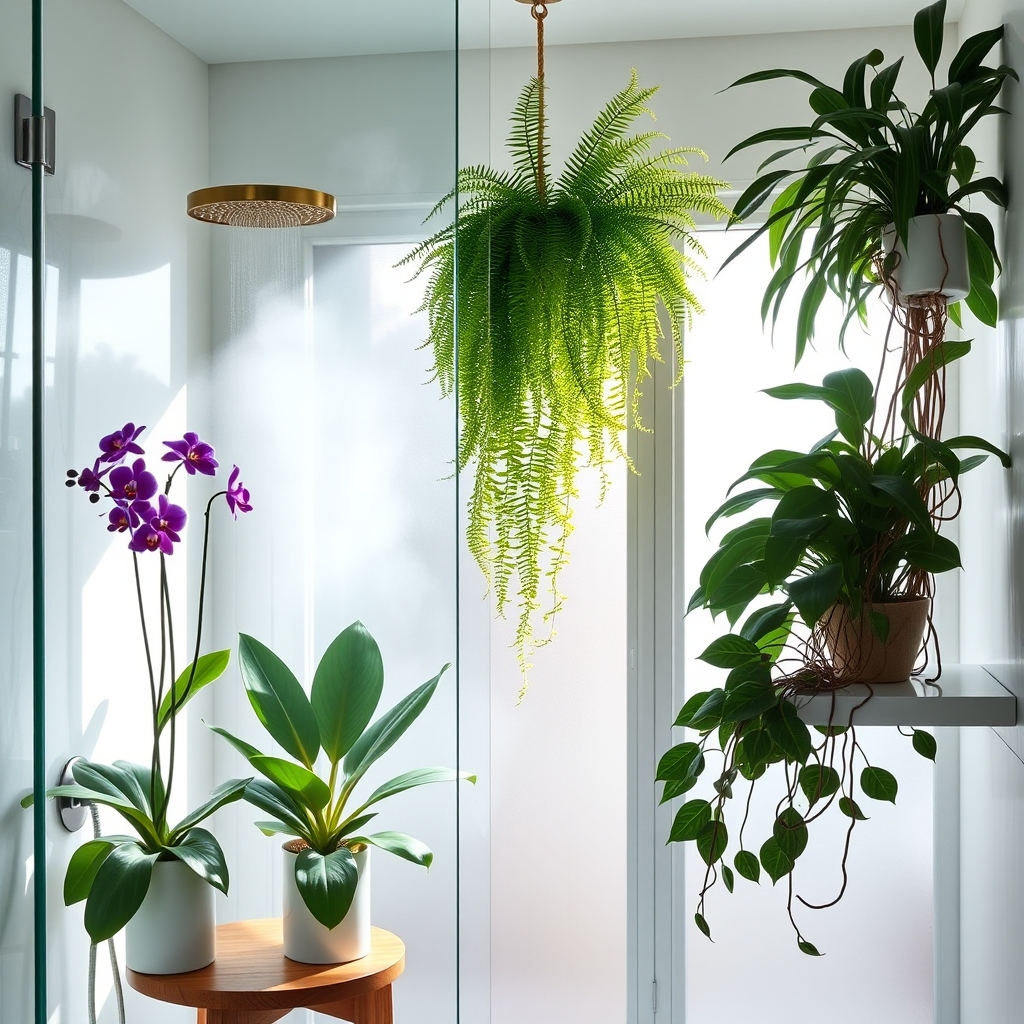
Humidity-loving plants that thrive in shower steam are tropical varieties adapted to moist environments with high moisture levels.
These plants typically feature broad, glossy leaves that efficiently capture water droplets and absorb ambient humidity. Common examples include Boston ferns with their delicate, arching fronds; orchids displaying exotic blooms; peace lilies with their elegant white flowers; and spider plants with cascading variegated leaves.
The unique feature of these plants is their ability to flourish in bathroom conditions, where regular shower use creates a natural greenhouse effect.
Their leaf structure and root systems are specifically designed to absorb moisture from the air rather than solely relying on soil water.
Many of these plants also help purify the air and reduce bathroom mold by absorbing excess moisture through their foliage.
Space-Saving Hanging Plants for Small Bathrooms
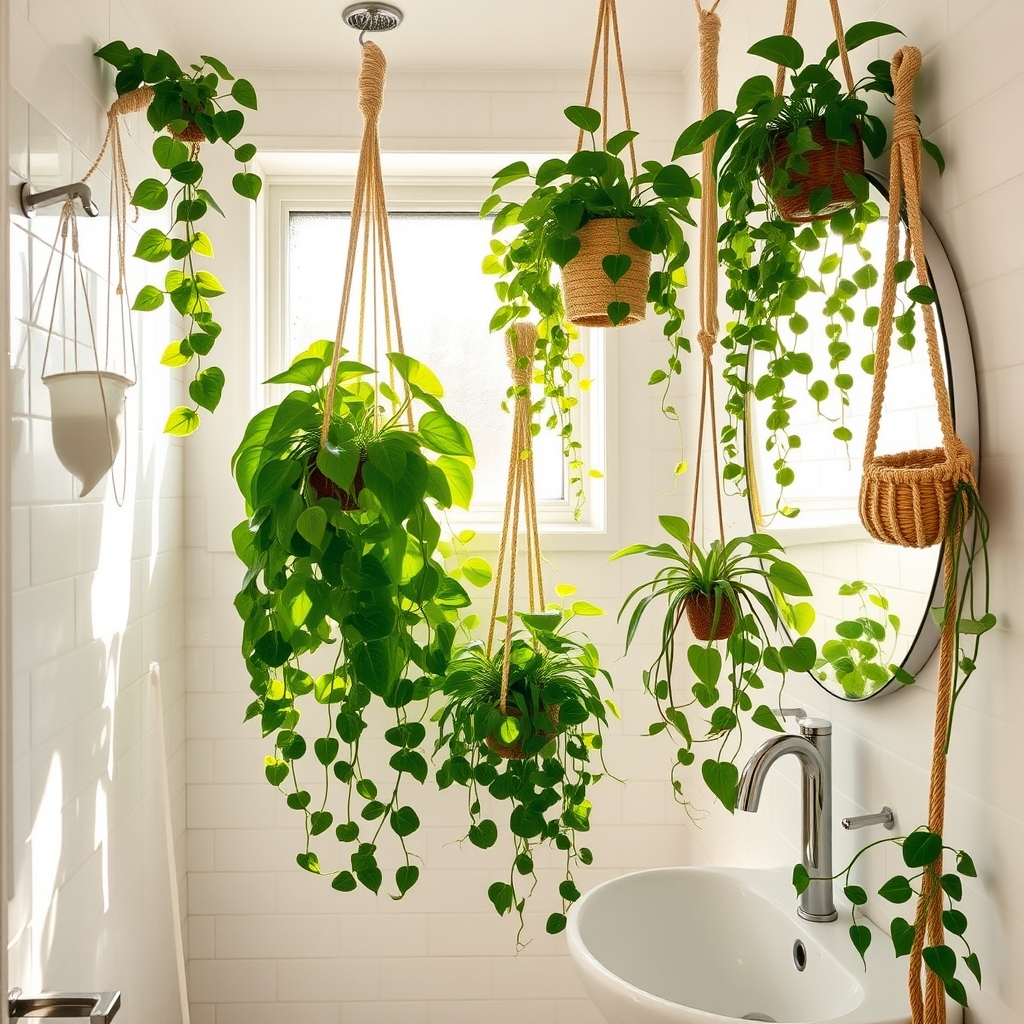
Space-saving hanging plants for small bathrooms consist of compact, suspended greenery that maximizes vertical space while minimizing counter and floor footprint.
These plants typically hang from ceiling hooks, shower rods, or wall-mounted brackets using macramé hangers, decorative chains, or simple plant holders.
Popular options include trailing plants like pothos, string of pearls, and spider plants, which cascade downward creating an elegant waterfall effect.
The hanging mechanisms can be adjusted to various heights, allowing plants to be positioned away from high-traffic areas while still receiving adequate light from windows or artificial sources.
These suspended garden elements add visual interest to bathroom spaces without cluttering limited surface areas, making them ideal for compact powder rooms, narrow bathrooms, or spaces with minimal storage.
Many suitable varieties thrive in humid bathroom environments and require minimal maintenance, functioning as both space-efficient decor and natural air purifiers.
Air-Purifying Plants to Combat Bathroom Odors
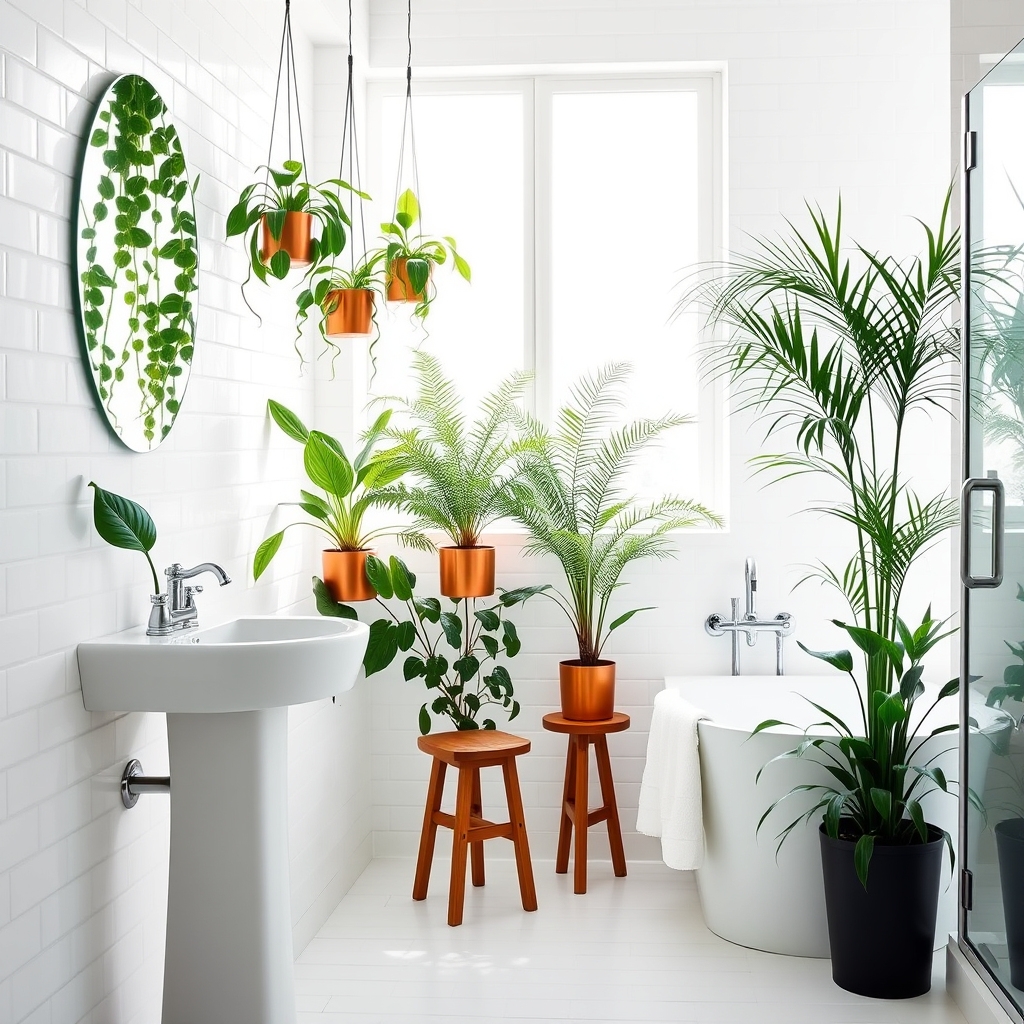
Air-purifying plants for bathrooms serve as natural deodorizers while adding aesthetic value to the space.
These plants actively filter airborne toxins and help neutralize unpleasant odors through their natural metabolic processes.
Common effective options include:
- Peace Lily – Dark green leaves with white flowers, removes airborne toxins and excess moisture
- Spider Plant – Long, striped cascading leaves, excellent at filtering formaldehyde and other chemicals
- Boston Fern – Feathery, arching fronds, naturally humidifies air and removes indoor pollutants
- Snake Plant – Tall, rigid leaves with yellow edges, converts CO2 to oxygen at night
- Bamboo Palm – Multiple stems with delicate leaves, effectively filters benzene and trichloroethylene
These plants thrive in humid bathroom environments and require minimal maintenance.
Most can survive in low to moderate light conditions typical of bathrooms.
Their natural filtration occurs through leaf pores that absorb air pollutants while releasing clean oxygen, making them ideal for small, enclosed bathroom spaces.
Water-Resistant Plants for Wet Environments
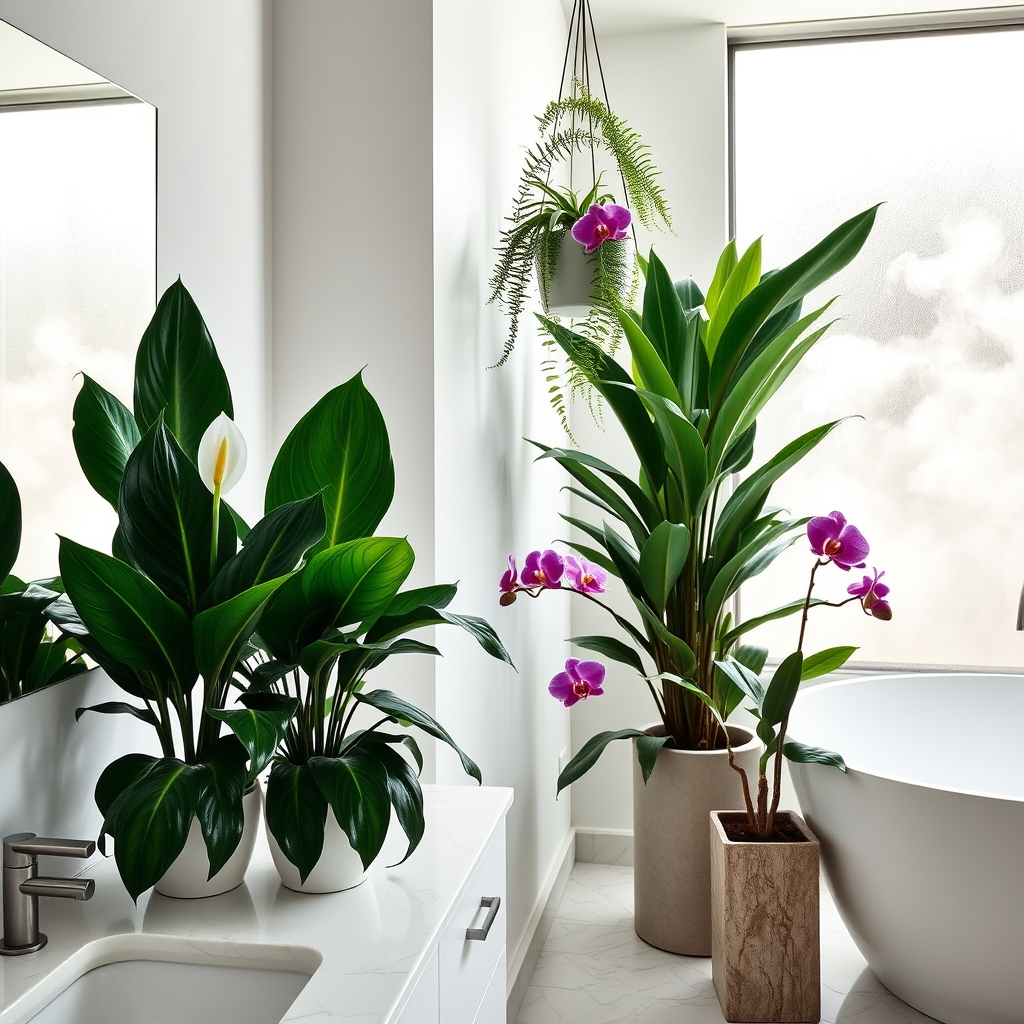
Water-resistant plants for wet environments are species specifically adapted to thrive in high-humidity and moisture-rich conditions typical of bathrooms.
These plants typically feature thick, waxy leaves that repel excess water and prevent fungal growth, along with strong root systems that can handle variable moisture levels.
Common characteristics include:
- Broad, glossy foliage that sheds water easily
- Aerial roots that can absorb moisture from the air
- Dense, compact growth patterns
- Ability to filter air and reduce bathroom humidity
Popular examples include:
- Peace lilies with their white spathes and dark green leaves
- Snake plants featuring tall, rigid, water-resistant leaves
- Bamboo varieties with segmented stems
- Boston ferns with their feathery, moisture-loving fronds
- Orchids that naturally grow in humid, tropical environments
These plants not only survive but flourish in bathroom conditions, making them ideal for spaces with frequent temperature changes and water exposure.
Bathroom Plants That Require Minimal Maintenance
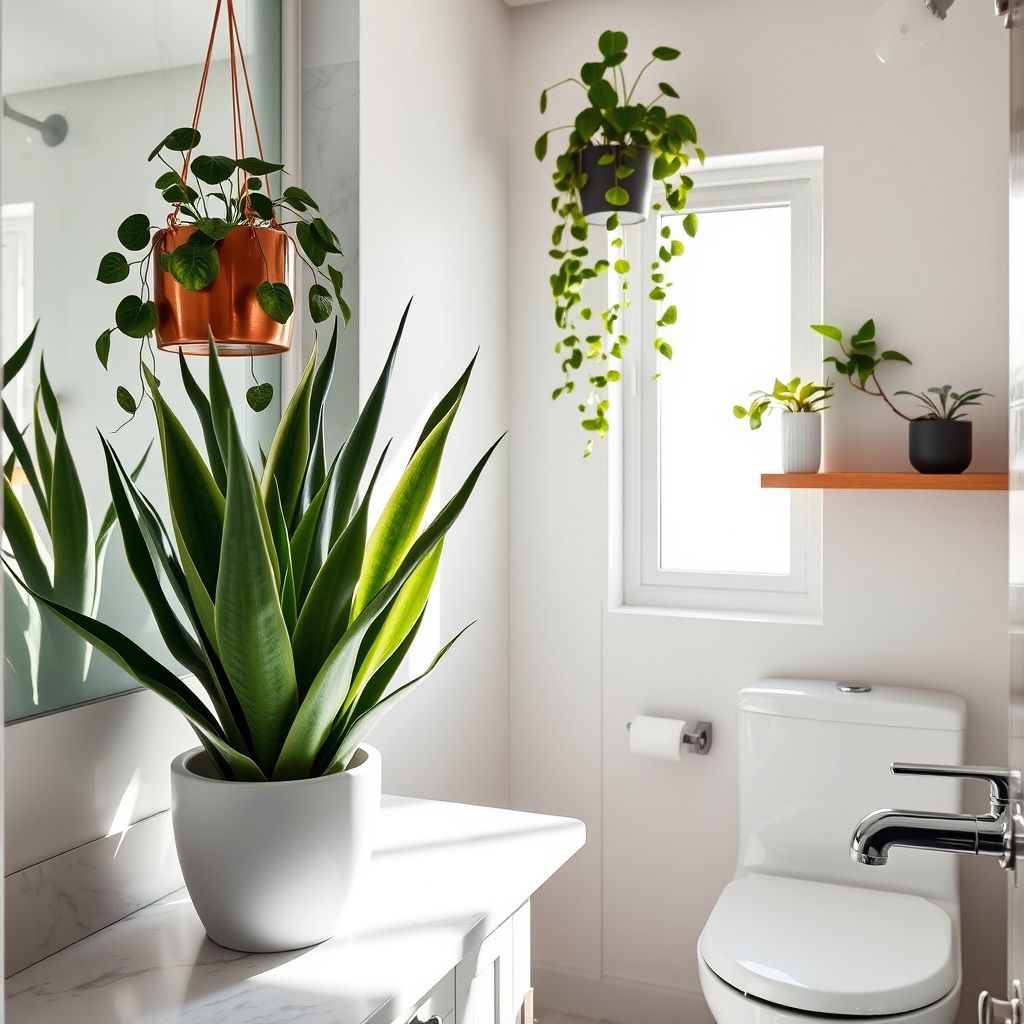
Low-maintenance bathroom plants are species specially adapted to thrive in humid environments with minimal care requirements. These plants typically feature thick, waxy leaves that help retain moisture and resist bathroom temperature fluctuations.
Common examples include snake plants, pothos, and ZZ plants, which can survive in low-light conditions and irregular watering schedules.
These plants generally exhibit sturdy stems, compact growth patterns, and resilient foliage that resists mold and mildew. Many varieties can be placed on windowsills, countertops, or hung from shower rods, requiring only occasional pruning and monthly fertilization during growing seasons.
Their self-sufficient nature makes them ideal for busy homeowners who want to add greenery to their bathrooms without demanding care routines.
Key characteristics include:
- Drought-tolerant foliage
- Ability to thrive in artificial light
- Resistance to humidity damage
- Long intervals between watering needs
- Natural air-purifying qualities
Colorful Plants to Brighten Your Bathroom Space
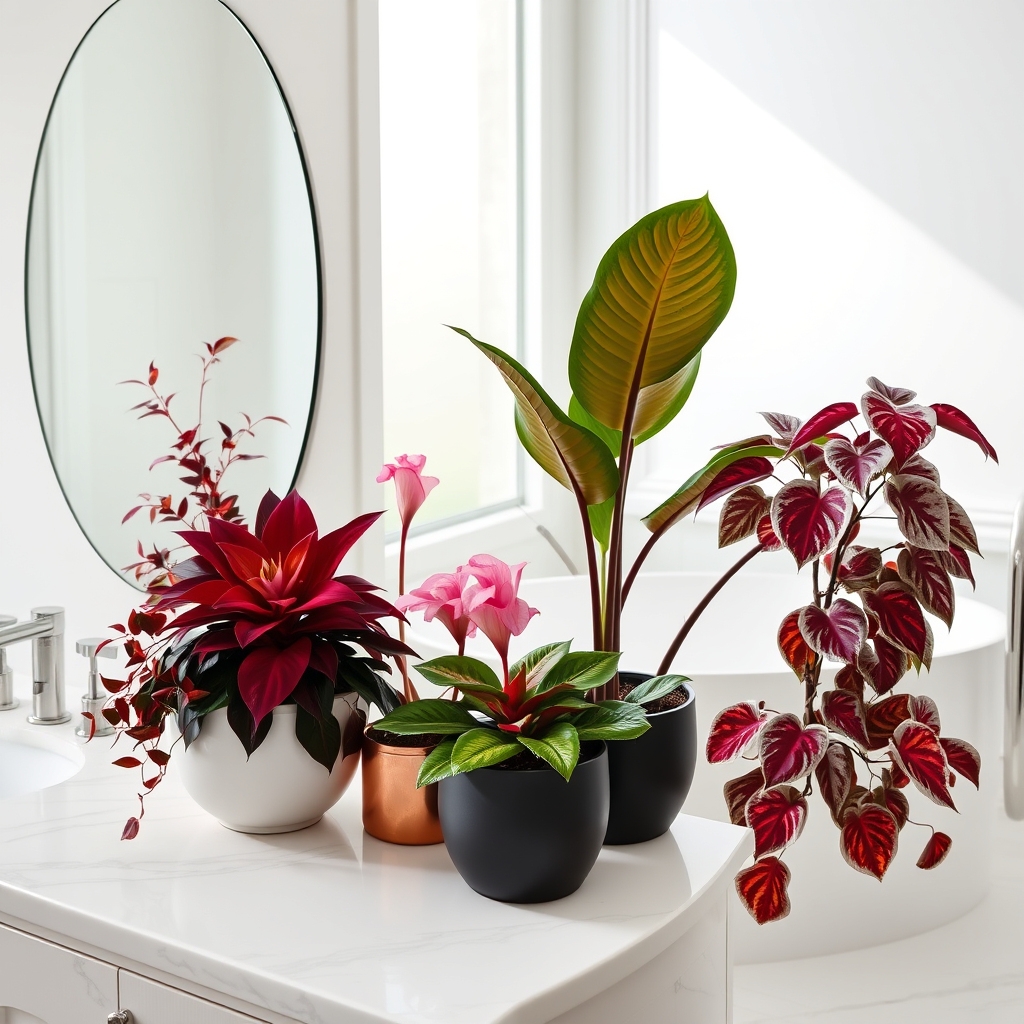
Colorful plants can transform a sterile bathroom into a vibrant, spa-like retreat. These plants add visual interest through their varied hues, including:
- Purple-tinged Chinese Evergreen with its deep burgundy leaves
- Pink-flowering Bromeliads that bloom in bright, tropical colors
- Croton plants displaying bold patterns in red, orange, and yellow
- Peace Lilies featuring white flowers against dark green foliage
- Rex Begonias with spiral patterns in pink, silver, and purple
- Red Aglaonema showing off pink and red-streaked leaves
Many of these plants thrive in bathroom conditions due to higher humidity levels and indirect light.
Their colors remain vivid even in lower light conditions, making them ideal for brightening darker bathroom spaces while requiring minimal maintenance.
The combination of different colored plants creates depth and visual interest in an otherwise monochromatic space.
Pet-Safe Plants for Family Bathrooms
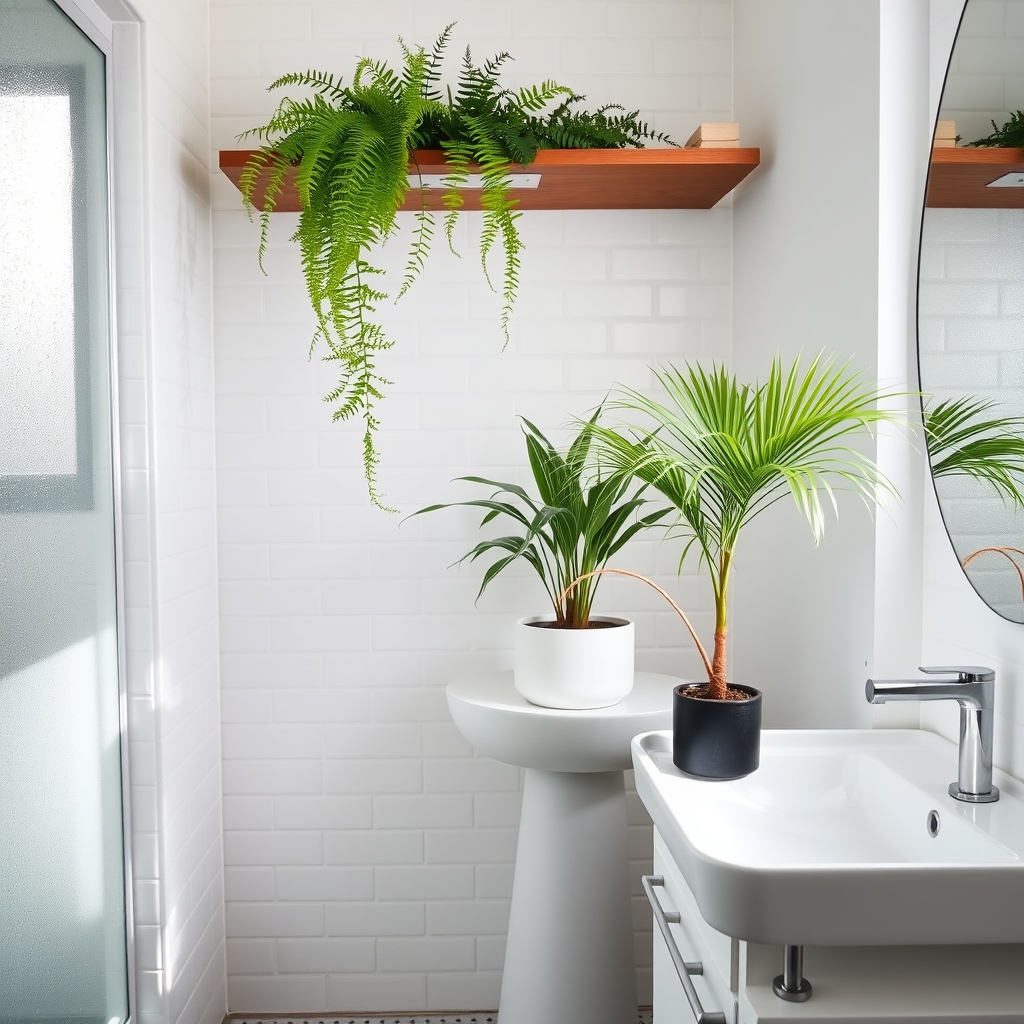
Pet-Safe Plants for Family Bathrooms compiles non-toxic plant options suitable for households with pets.
These specially selected plants are safe if accidentally ingested by cats, dogs, or other domestic animals while adding natural beauty to bathroom spaces.
Popular choices include Boston Ferns with their cascading fronds, moisture-loving Spider Plants with their arching leaves, and compact Parlor Palms with delicate foliage.
Pet-safe bathroom plants typically thrive in humid conditions, require minimal sunlight, and won’t cause harm if curious pets nibble on their leaves.
Many of these plants serve dual purposes – purifying bathroom air while being completely non-toxic to animals.
Decorative Placement Ideas for Bathroom Plants
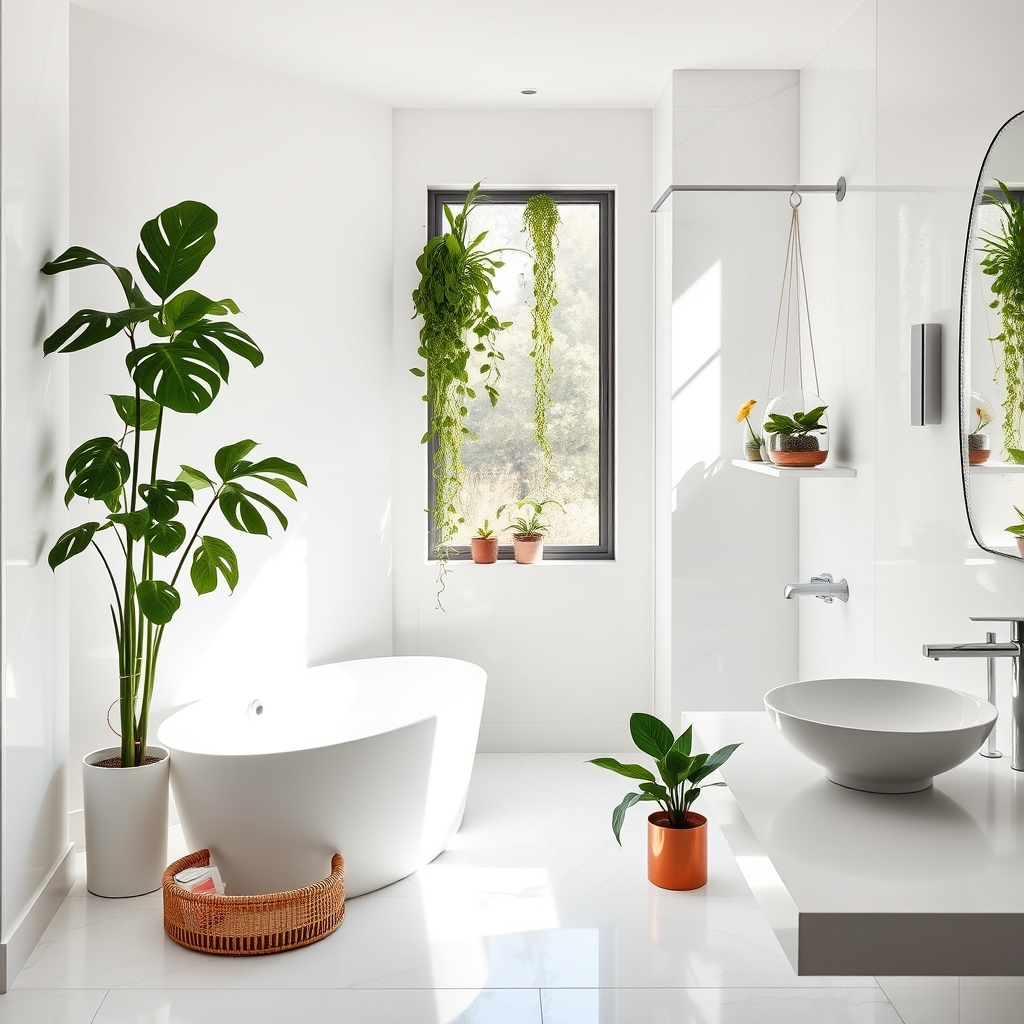
Strategic placement options for bathroom plants that enhance the room’s aesthetic appeal and functionality:
- Window sills: Optimal spots for light-loving plants, creating natural privacy screens while maximizing natural light exposure.
- Counter arrangements: Compact plants placed near sinks add visual interest without cluttering counter space.
- Wall-mounted displays: Hanging planters and vertical gardens save floor space while creating living wall features.
- Shower caddies: Moisture-loving plants positioned in shower areas benefit from humidity and create spa-like ambiance.
- Corner installations: Tall plants in bathroom corners add height and drama without impeding traffic flow.
- Over-toilet shelving: Cascading plants on shelves above toilets utilize otherwise unused vertical space.
- Bathtub surrounds: Plants placed near tubs create a serene, natural setting for relaxation.
- Vanity accents: Small potted plants complement bathroom fixtures and personal care items.
These placement strategies work with the bathroom’s existing architecture while incorporating natural elements that thrive in humid conditions.
